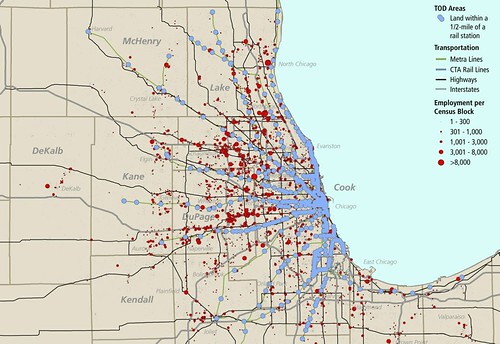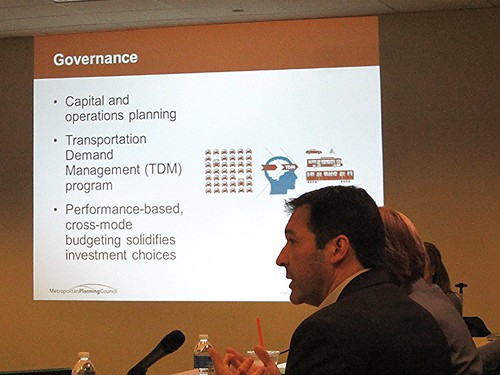Testifying before the Northeastern Illinois Public Transit Task Force Friday, the Metropolitan Planning Council’s Peter Skosey argued that the region could significantly increase transit ridership by encouraging jobs and development near existing stations.
Governor Pat Quinn created the 15-member task force last summer in the wake of the controversial ouster of Metra CEO Alex Clifford. Clifford, who received a $871,000 severance, claimed he was forced out by Metra board members because he wouldn’t bow to political pressure on hiring and contract decisions. At the end of the month, the task force is expected to issue recommendations for creating to create a fiscally and ethically sound regional transit system. The public can provide input for the report here.
Speaking during the public comment portion of the meeting, Skosey said the MPC wants to provide backup for the task force as it pushes for transit reform. “We aren’t the only ones holding our breath and waiting for this important report to come out,” he said. “We want to embolden you guys to be as bold as you can be in your recommendations.”
After noting that reducing corruption and inefficiency in public transportation governance is key for making the regional transit system more viable and building public support for more transit investment, he launched into a discussion of how to increase ridership.
Skosey noted that Chicagoland’s GO TO 2040 plan calls for doubling transit ridership by 2040. The region is currently adding 12 million new transit trips annually, but we need to be adding 21 million trips a year to meet that goal, he said. It won’t necessarily require doubling the amount of transit spending to achieve that milestone but rather better strategy and urban planning, he added.
A regional transportation demand management program, which would help coordinate the services of the transit agencies, as well as car-sharing, bike-sharing, emergency ride home and other services, would be a step in the right direction, he said. “In fact we’re engaged in conversations right now with the RTA and IDOT on just how to do that for this region."
Skosey noted that better land use, with more people living and working near transit, will lead to higher ridership. He showed a map with blue dots illustrating half-mile radii around transit stations in the region, with red dots marking large employment nodes, which are largely centered around highways and interstates.
“You see the existing mismatch, how we could start to bring those two dots closer together,” he said. “Clearly developing new transit lines and office towers is an expensive proposition. This situation didn’t arise overnight. It literally arose over several decades, so it’s going to take time to redress it, but it is a goal that we should really keep in our sights.”
Skosey showed another map illustrating that the while CTA Blue and Green lines on the South and West sides have a lot of empty seats, there is also high vacancy in the housing stock in these areas. If the land around these stations could be repopulated, the transit infrastructure would already be in place to serve the additional residents. He also mentioned the Southeast Side as an area that is well-served by Metra rail lines but has a relatively low population, making it a good candidate for infill development.
Region-wide, there’s an opportunity for one-half-million new residents to live within a quarter-mile of transit, as well as room for over 100 million square feet of commercial space, Skosey said. He citied a large mixed-use building proposed for the south suburban Tinley Park Metra stop as an example of a developer taking advantage of this opportunity.
“TOD must be a priority,” Skosey said. He urged the transit task force to recommend encouraging TOD as part of their report, noting that it may be possible for the state or other government entities to provide financial incentives for transit-friendly development.
Skosey concluded by addressing the funding issue, pointing out that Chicago spends far less per capita compared to peer cities like Washington, D.C., San Francisco, New York and London. He listed a host of possible strategies to increase local funding, including a vehicle miles traveled fee, indexing motor fuel taxes to inflation, property tax hikes, congestion pricing and carbon tax value capture, and more.
“New funding options can provide operations and capital expansions necessary to attract new riders and better serve existing riders,” he said. “None of them are particularly politically exciting. If you are a legislator in Springfield or a county board member, you don’t want to vote for any of these things, I’m sure. But they have to be considered.”







